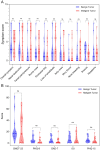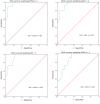Psychiatric disorders in patients with benign and malignant sinonasal tumors: a prospective cross-sectional study
- PMID: 39723395
- PMCID: PMC11668606
- DOI: 10.3389/fpsyg.2024.1444522
Psychiatric disorders in patients with benign and malignant sinonasal tumors: a prospective cross-sectional study
Abstract
Objective: To assess the prevalence of depression, anxiety, insomnia, and somatic symptom disorder (SSD) in patients with benign and malignant sinonasal tumors.
Materials and methods: Pretreatment patients with sinonasal tumors were prospectively recruited on the rhinology ward of a tertiary hospital from July 2021 to March 2022. The electronic questionnaire which contains the rhinological symptom scale, the 22-item Sinonasal Outcome Test (SNOT-22) Scale, the Patient Health Questionnaire-9 (PHQ-9), the Generalized Anxiety Disorder-7 (GAD-7), the Insomnia Severity Index (ISI), and the Patient Health Questionnaire-15 (PHQ-15) was filled out by patients at admission. The associations between the scores of symptom/SNOT-22 and psychometric tests were assessed by the Pearson correlation coefficient (r) and simple linear regression. The receiver operating characteristic (ROC) analysis was used to evaluate the performance of the SNOT-22 score in predicting psychiatric disorders.
Results: Thirteen patients with benign sinonasal tumors and 15 patients with malignant sinonasal tumors were recruited. The benign and malignant groups did not differ significantly regarding symptomatology and mental wellbeing. Of the total patients, 9 were at risk of depression (PHQ-9 > 4), 10 were at risk of anxiety (GAD-7 > 4), 11 were at risk of insomnia (ISI > 7), and 11 were at risk of SSD (PHQ-15 > 4). The overall symptom, facial pain/pressure, postnasal drip, and SNOT-22 scores were positively associated with scores of psychometric tests. Patients with a high SNOT-22 score (>18) are likely to be affected by comorbid psychiatric disorders. When interpreting the results of this study, it should be noted that screening tools, not diagnostic tools, were used to identify psychiatric risk.
Conclusion: Depression, anxiety, insomnia, and SSD are prevalent in patients with sinonasal tumors. Otolaryngologists should have a low threshold to ask the patient about psychiatric symptoms, especially for patients with an SNOT-22 score > 18.
Keywords: anxiety; depression; insomnia; sinonasal tumor; somatic symptom disorder.
Copyright © 2024 Zhan, Wang, Wang, Wen, Zhong, Wen, Li and Peng.
Conflict of interest statement
The authors declare that the research was conducted in the absence of any commercial or financial relationships that could be construed as a potential conflict of interest.
Figures




Similar articles
-
Screening for Psychiatric Disorders in Chronic Rhinosinusitis Patients Waiting for Surgery: A Prospective Cross-Sectional Study.Clin Otolaryngol. 2025 Jan;50(1):88-97. doi: 10.1111/coa.14239. Epub 2024 Oct 2. Clin Otolaryngol. 2025. PMID: 39358666
-
PHQ-9 and SNOT-22: Elucidating the Prevalence of Depression in Chronic Rhinosinusitis.Otolaryngol Head Neck Surg. 2020 Jan;162(1):142-147. doi: 10.1177/0194599819886852. Epub 2019 Nov 12. Otolaryngol Head Neck Surg. 2020. PMID: 31711363
-
Depression and Anxiety: Considerations for Interpretation of the SNOT-22 (22-Item Sinonasal Outcome Test).Otolaryngol Head Neck Surg. 2022 May;166(5):985-992. doi: 10.1177/01945998211059732. Epub 2021 Nov 9. Otolaryngol Head Neck Surg. 2022. PMID: 34752155
-
General illness and psychological factors in patients with chronic nasal symptoms.Clin Otolaryngol. 2018 Apr;43(2):609-616. doi: 10.1111/coa.13032. Epub 2017 Dec 13. Clin Otolaryngol. 2018. PMID: 29150985
-
Status quo and influencing factors for anxiety, depression, and insomnia among 4 237 nurses in Hunan Province.Zhong Nan Da Xue Xue Bao Yi Xue Ban. 2021 Aug 28;46(8):822-830. doi: 10.11817/j.issn.1672-7347.2021.210212. Zhong Nan Da Xue Xue Bao Yi Xue Ban. 2021. PMID: 34565725 Free PMC article. Chinese, English.
References
LinkOut - more resources
Full Text Sources

